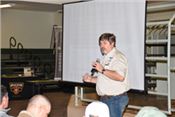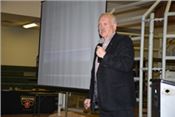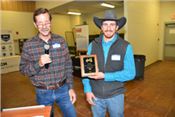|
Forage Producers Hear Importance Of Soil Health At Annual Meeting

Guillermo Scaglia, LSU AgCenter animal scientist, discusses the
importance of linking forage testing to beef cattle nutrition.
ALEXANDRIA, LA.
Forage producers discussed the benefits of good soil health at the Louisiana Forage and Grass Council annual conference.
Farmers and ranchers from areas around the state heard from a variety of speakers about what works best in pastures, for pollinators and in wildlife food plots.
The annual meeting featured presentations from U.S. Department of Agriculture and LSU AgCenter professionals along with private producers who have unique forage production operations.
LSU AgCenter forage specialist Ed Twidwell, secretary for the council, said each year the organization tries to bring in speakers who can cover a variety of topics, which include vendors and producers to give their experiences in growing forages.
Gerald Smith, professor and plant breeder with Texas A&M Agrilife, talked about his 40 years of forage legume breeding and the cooperation between Louisiana and Texas breeding programs.
“We like to work together where we have similar soils and are able to help each other to develop a forage that works well in both locations,” he said. “We depend on AgCenter breeders to help in developing legumes and other forages and to find out what problems producers may be having with new plants.”
Guillermo Scaglia, an AgCenter animal scientist, discussed the importance of linking forage testing to beef cattle nutrition.
“We want the producers to understand the needs of different cattle such as bulls, mature cows and heifers,” he said. “We also talked about the importance of different types of forages as well as supplemental feeding.”
Cooper Hurst, a cattle producer from Woodville, Mississippi, presented information on the importance of regenerative ranching, focusing on grazing and soil health.
Hurst discussed the importance of moving the cattle to fresh pasture in rotational grazing.
“We are building our soils and building the resiliency and improving our water infiltration,” he said.
“We can’t make it rain, but we can control how much runs off and how much is absorbed by the ground.”
Katy Bridges, an LSU graduate student, followed up with the results of her soil health research project.
Chris Ebel, range management specialist for Natural Resources Conservation Service and president of the council, said the topics for the meeting don’t change a lot from year to year, but it always is of interest to cattle producers, pollinators and those interested in forage for wildlife.
John Pitre, also of the NRCS, stood in for state conservationist Kevin Norton to give an update on programs at his agency.
At the close of the meeting, Twidwell and Ebel presented the Master Forage Award to Conner Hays, of Sulphur.
Hays said the award shows that he has improved in the management of his family’s 2,800-acre operation that runs an average of 500 head of cattle.
“My family has owned this operation since 1873, and this award shows that out of my many failures, I’m getting better at this,” Hays said.
The conference ended with the annual business meeting where Jeff Foster, of Dubach, became the new president of the organization. ∆

Gerald Smith, professor and plant breeder with Texas A&M Agrilife, talks about his 40 years of forage legume breeding and the cooperation between Louisiana and Texas with their breeding programs at the
Louisiana Forage and Grassland Council annual conference in Alexandria.
Photo by Johnny Morgan/LSU AgCenter

Conner Hays, right, receives the Master Forage Producer Award from Chris Ebel, president of the Louisiana Forage and Grassland Council,
at the council’s annual conference in Alexandria.
|
|